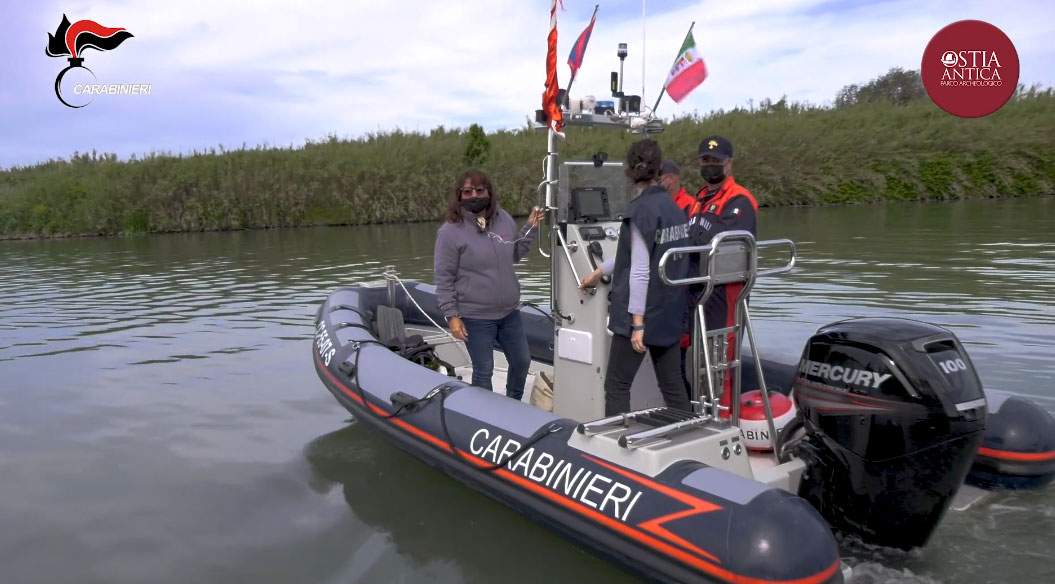Three Roman column shafts have been found in Rome lying on the Tiber riverbed. They were discovered by the Nucleo Carabinieri Subacquei di Roma, with the participation of archaeologist Alessandra Ghelli, newly appointed head of the Servizio Tutela del Patrimonio Subacqueo (Underwater Heritage Protection Service), newly established by the Ostia Antica Archaeological Park. The investigations started from the mouth of the Tiber and went up the course of the Fossa Traiana, the Fiumicino canal built by the architects of the Empire. Numerous dives took place from Capo Due Rami, reached by two vessels of the Carabinieri Scuba Diving Unit in Rome.
The discovery was made by tact, given the no-visibility conditions of the river bottom. During the various dives, Carabinieri came across numerous submerged debris including remains of hulls, decaying animal carcasses, as well as medium and large logs carried by the current. “The activities in May focused on the seabed of the Fossa Traiana, or the artificial canal dug by Emperor Trajan to connect the port, his harbor, with the Tiber and which corresponds to today’s Fiumicino Canal,” says archaeologist and diver Alessandra Ghelli. The river environment is one of the most hostile environments where one can operate, and despite the shallow depths, not exceeding 8-10 meters, the possible threats and dangers are multiple and invisible. In fact, already after the first 2 meters, due to the high density of the dissolved silt, the water takes on a brownish-blackish color, to become very dark at depth, thus preventing the Carabinieri divers from benefiting from sight, which in fact in operations has been replaced entirely by touch. The divers, forced to use increased ballast, which was essential to be more adherent to the bottom and effectively counteract the current, crawled on all fours using only their hands to feel their surroundings.
“Although the column drums are large,” adds Alessandra Ghelli, “finding and locating them was difficult, it was purely tactile work, especially because of the degree of visibility, which on the bottom is zero. But the other difficulty is always the presence of the currents, so when working underwater in the Tiber you have to anchor yourself on the seabed very solidly and you have to go upstream almost as if you were crabs.” Also participating in the search campaign in the Fossa Traiana were Carabinieri from Rome’s Nucleo Tutela Patrimonio Culturale, which carries out periodicmonitoring and control activitiesof marine and river archaeological sites, with the support of Rome’s Carabinieri Diving Unit and related naval units, to consolidate the prevention of and fight against the phenomena of damage and theft of submerged cultural heritage.
The three columns found were the subject of punctual photo-descriptive surveys and immediately surveyed within the database of the Carabinieri Command for the Protection of Cultural Heritage, an activity that will allow their instantaneous identification in case of any theft and/or damage. While waiting for the precious finds to be brought back to the surface to be valorized and returned to the state’s unavailable heritage, the Rome TPC Nucleus, together with the Carabinieri Scuba divers, will patrol and monitor the area to prevent the commission of crimes. The need to photograph the finds, as well as to have the most faithful measurements possible, required the use of top-notch cameras, properly set up, which made it possible to record images of the finds that would have been impossible to see with the naked eye. The entire adventure can be relived thanks to the narrative recorded during the dives, with comments from the archaeologists and sequences taken on the river and underwater.
For Alessandro D’Alessio, director of the Archaeological Park of Ancient Ostia, “the christening of the new underwater archaeological protection service of the Park of Ancient Ostia could not have been more fortunate. The first campaign completed by Dr. Alessandra Ghelli (with the collaboration of the Rome Underwater Carabinieri and the Rome Cultural Heritage Protection Unit) led to the identification in the waters of the Tiber, at a depth of five meters, of three large marble column shafts. Although partially buried in the bed and embankment, the columns exceed one meter in diameter and two and a half meters in length. But how did they end up in the Tiber? Imperial Rome, in the first centuries A.D., was undoubtedly the most coveted landing place, the most flourishing of markets for marble from quarries scattered all over the Mediterranean, from Spain to the Black Sea, via the Egyptian coast. Sometimes a small portion of the cargoes entrusted to river transport against the current along the Tiber, destined for the marble station at Testaccio, would be subject to accidents on the way and once overboard would become difficult to salvage, especially if they were as imposing in size as our columns. With the next appointment with underwater heritage protection, we will try to take small samples, to determine the type of marble and its origin. The Carabinieri has already pledged its contribution, and together we hope to achieve in the medium term the recovery of the columns.” A video illustrating the discovery is available on the park’s Vimeo channel.
Pictured are Alessandra Ghelli and Carabinieri on one of the military’s vessels.
 |
| Rome, three Roman column shafts found at the bottom of the Tiber River |
Warning: the translation into English of the original Italian article was created using automatic tools. We undertake to review all articles, but we do not guarantee the total absence of inaccuracies in the translation due to the program. You can find the original by clicking on the ITA button. If you find any mistake,please contact us.